
As a child, once you left your bedroom did you ever imagine that your toys would have a life of their own? Pixar’s two movies, Toy Story and Toy Story 2, take this concept to a whole new level through stunning computer animation and heart-warming story lines. In the first film, Toy Story, Andy’s favorite toy Woody, a pull-string cowboy, is confident in his role as room leader. But a birthday party for Andy brings up worries over being replaced with a newer or better toy – and that toy turns out to be Buzz Lightyear, a flashy space ranger with laser action, voicebox, karate chop and pop-out wings. Buzz, however, really believes that he’s the real Buzz Lightyear – not just a toy. His deluded but charming personality wins the admiration of Andy’s other toys, but inspire a rivalry with Woody for Andy’s affections. During a moment of weakness, Woody accidentally knocks buzz outside – into the real world. Andy, disappointed not to find Buzz, takes Woody along with him to dinner, but at a gas station Buzz catches up with Woody and they’re both knocked out of the car – and left alone. From there they must work together to escape the clutches of the toy-torturing boy next door and get back to Andy before he moves – and in doing so realize they’ve got the perfect friend, in each other.
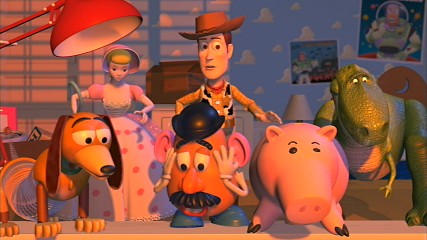
In Toy Story 2, the family has completed the move to their new neighborhood. Just before Andy leaves for Cowboy camp, Woody’s arm is ripped at the shoulder and consequently he’s left behind. Woody is horrified that he’s wearing out and may no longer be played with. Placed on the top shelf out of reach of danger, Andy meets up with a long-forgotten toy, Wheezy, a squeaky penguin. Alone without Andy, Woody and the gang face a new horror – the yard sale. When Andy’s mom comes in looking for things to unload, poor Wheezy is placed into the 25 cent box. Andy, determined to rescue him, risks going outside with the help of Andy’s dog and successfully reclaims Wheezy from the bargain box. But before he can get back inside, he’s snatched up by Al, of Al’s Toy Barn. It turns out that Andy’s a valuable collector’s item... and the perfect keystone piece for Al’s "Woody’s Roundup" collection. Buzz and the others, realizing that Andy has been kidnapped, venture out into the real world in order to rescue him. What hope can the ragtag group of toys have in the real world? Well, nothing’s too difficult for Buzz Lightyear!
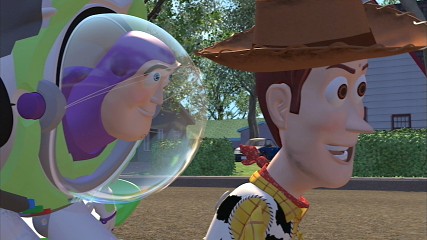
This special edition of Toy Story and Toy Story 2 comes on three discs – one for each movie, plus one packed full of supplemental material. Another version of the movies, packaged on two discs, includes the same video transfers but no special features. Since the technical merits of both movies are so similar, they will be reviewed together.
As one would expect from a pure digital-to-digital transfer, the video quality in both Toy Story and Toy Story 2 is nothing short of perfect. It’s simply impossible to find any defects. There’s no dirt, lint, noise, grain, blooming, or anything else undesirable. The 1.77:1 anamorphic widescreen transfers truly bring the amazing computer-generated worlds to life with incredible details with vibrant colors. Being able to see every painstakingly placed wear mark on a door jamb or oil stain on a road really brings a new appreciation for the hard work of the Toy Story creators. Pixar is one of the best "high quality, attention to detail" companies out there – and this DVD is proof positive. True reference material. The original Toy Story movie is divided into 30 chapters. The dual-layered disc contains 7.3 gigabytes of data, with the layer change occurring at the beginning of chapter 26, or 1:04.12 into the entire film. Toy Story 2 is divided into 35 chapters and stored on a dual-layered disc containing 5.3 gigabytes of data, with the layer change at 05.24 into chapter 22, or 0:52.02 into the movie.
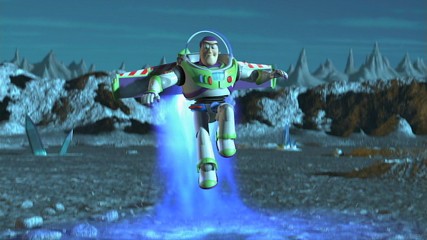
The audio is slightly different between the two films. While both use remarkably active Dolby Digital 5.1 mixes, I found the dialogue track on the original Toy Story, several years older, to suffer somewhat from a lack of clarity and minor clipping, while the overall mix felt a little harsh. Not so on Toy Story 2, which – if possible – includes an even wilder track with heavy bass and loads of rear channel usage. Being direct digital transfers, the sound comes through with stunning clarity. To show your system off to non-DVDers, pop Toy Story 2 in and take them through the first few minutes. Speaking of which, both movies include unique THX trailers that are positively hilarious – not to mention being an excellent demonstration of the brilliant soundtracks to follow! Also on both discs are French 5.1 audio tracks, English Closed Captioning and THX OptiMode system setup tests.
Now for the frosting on the cake– the supplemental features. First, both movies include director’s commentary tracks. Toy Story incorporates the same track as on the earlier laserdisc release, so all participants are reintroduced after each "side break" – which of course doesn’t happen on DVDs. The track for Toy Story 2 was done strictly for the DVD. Also on each disc is an isolated 5.1 special effects soundtrack. And neither disc has forced preview trailers!
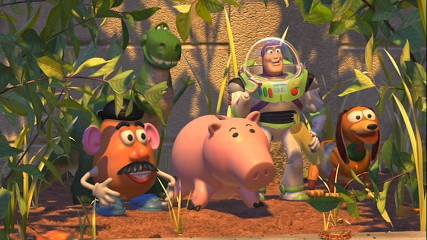
Despite having a separate disc for supplemental features, the first Toy Story disc includes a fair bit of extra material. First is "Tin Toy", one of Pixar’s early short-film creations from 1988. "Tin Toy" was incredibly advanced for it’s time period, although the baby was often described as having a concrete diaper. Next is a 27-minute documentary, "The Story Behind Toy Story", which delves into the making of their first feature-length animated film. There’s two 2-minute short "on-set" interviews with Buzz and Woody, plus the full "Buzz Lightyear" television commercial that you never get to see entirely in the movie. An amazing 52 "Toy Story treats" are included – these are short animations that ABC used between commercial breaks during Saturday morning cartoons. Finally, there’s a multi-language reel that demonstrates, in a single clip, the 30-different international languages that Toy Story was created in.
The Toy Story 2 disc has a more limited compilation of extras, featuring one of Pixar’s famous outtakes reels, their first animated short, "Luxo Jr.", plus preview trailers for their next movie "Monsters Inc." and for the earlier released cell-animated movie "Buzz Lightyear of Star Command: The Adventure Begins".
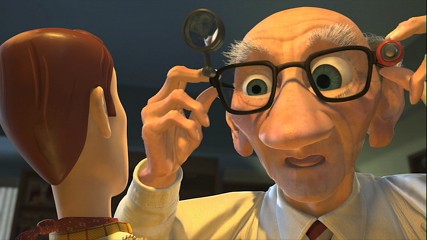
And now for the real treat. The third disc, "Special Features", packs in 7.5 gigabytes of interesting material. Divided into two sections, one for each film, the material is logically arranged into separate categories. For the original Toy Story, the "History" section includes the history and development of the film, early proof-of-concept tests, original scripts, production notes and cast biographies. The "Design" section includes step-by-step design development of 6 characters with photos, art design, designing Toy Story, concept art, a script made out of color artwork and color key drawings. Photo galleries for the environmental design of Andy’s room, the gas station, Pizza Planet and Sid’s room are available; most also include narrated 3D tours. The "Story" category includes an original storyboard pitch, how they edited the story, a story reel, plus a comparison of storyboards to the finished film. Abandoned concepts include a Buzz Lightyear cartoon, a western shoot-out with Woody, Woody’s nightmare, the eastern gate, Shakes the Rattle, Sid’s comeuppance and a chase scene.
"Computer Animation" is probably where many folks will head to first. It includes a production tour of their facilities, tips and tricks used for layouts, an animation tour, character animation, shaders and lighting, how they build a shot, production progression and, finally, how they did some of the special effects including motion blur, reflections, rain, and smoke. The "Music & Sound" section includes descriptions of the overall sound design, plus a huge collection of Randy Newman demo music. "Deleted Animation" features a torture scene with Sid, a longer rain scene, plus funny examples of rendering bugs. Finally, the "Publicity" category includes two theatrical trailers in widescreen and 2.0 sound, 4 television spots and a photo gallery of their print ad campaigns.
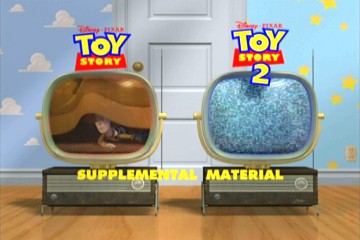 Since much of the technical details presented for the first Toy Story film were still valid for the second movie, Pixar decided to include different information that wouldn’t duplicate what was already available. The first section, "History", goes into why they made a sequel and how the story continued. Production notes and cast biographies are included, as is a special section dedicated to director John Lasseter. The "Story" category includes special in-depth looks at Woody’s nightmare scene, plus Jessie’s song. Here you’ll also find a hidden Easter egg – while on the main menu for Jessie’s Song, press the left arrow button. A little question mark will appear. Press enter to be treated to a special hilarious bit of animation.
Since much of the technical details presented for the first Toy Story film were still valid for the second movie, Pixar decided to include different information that wouldn’t duplicate what was already available. The first section, "History", goes into why they made a sequel and how the story continued. Production notes and cast biographies are included, as is a special section dedicated to director John Lasseter. The "Story" category includes special in-depth looks at Woody’s nightmare scene, plus Jessie’s song. Here you’ll also find a hidden Easter egg – while on the main menu for Jessie’s Song, press the left arrow button. A little question mark will appear. Press enter to be treated to a special hilarious bit of animation.
Once again the "Design" heading is packed full of detail including character design galleries, art design with a color script and lighting guide, plus photo galleries and 3D tours of Zurg’s planet, Andy’s house, Al’s apartment, Al’s Toy Barn and the airport. Unfortunately in many cases the so-called tours are nothing more than a repeating clip of a rotating camera placed in the middle of the room. I would have enjoyed longer, more specific guided tours of each room, with the designers pointing out special items of interest. Under "Computer Animation" you’ll find a production tour, production progression demo, and more details on special effects. For "Music & Sound" there’s a detailed look at the music for Jessie’s song, sound design, an interactive mixing demo, plus a music video demo.
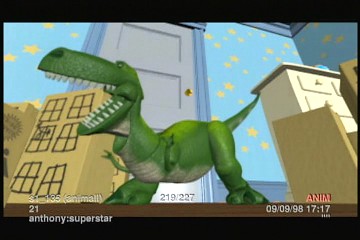 The "Deleted Animation" category features an earlier version of the road crossing scene set in a different environment, plus a deleted Godzilla Rex sequence. Under "Publicity" you’ll find two widescreen theatrical trailers with 2.0 sound and four television spots along with print ads and merchandise pictures. The "Toy Box" heading includes interviews with the cast on who they feel is the coolest toy and a guide to hidden jokes. A section dedicated to "Woody’s Roundup" takes a look at the manufactured collectibles, the design of the TV show, a music video starring Riders in the Sky plus, finally, an alternate version of an Americana scene from the movie geared to International audiences.
The "Deleted Animation" category features an earlier version of the road crossing scene set in a different environment, plus a deleted Godzilla Rex sequence. Under "Publicity" you’ll find two widescreen theatrical trailers with 2.0 sound and four television spots along with print ads and merchandise pictures. The "Toy Box" heading includes interviews with the cast on who they feel is the coolest toy and a guide to hidden jokes. A section dedicated to "Woody’s Roundup" takes a look at the manufactured collectibles, the design of the TV show, a music video starring Riders in the Sky plus, finally, an alternate version of an Americana scene from the movie geared to International audiences.
Pixar has the distinction of creating the very first completely computer animated feature-length films. They’ve also managed to assemble one of the most complete DVD movie bundles ever seen. The 3-disc set is packaged in separate Amaray cases which fit into a stylish metallic silver box, over which slips a transparent printed plastic sleeve. The set even includes a guide to where things are on the features disc. If you’re even remotely interested in how these film were created, it’s worth picking up this $70 USD compilation. Good movies, excellent transfers, fantastic extras.
- Reviewed by Daniel Tonks on October 23, 2000.

Toy Story
 |  |
| Movie: |
    |
| Video Quality: |
    |
| Audio Quality: |
    |
| Supplements: |
    |
1-Poor 2-Fair 3-Good 4-Excellent
|
Toy Story 2
 |  |
| Movie: |
    |
| Video Quality: |
    |
| Audio Quality: |
    |
| Supplements: |
    |
1-Poor 2-Fair 3-Good 4-Excellent
|
System Equipment
Sony DVP-S500D DVD Player
Sony STR-GA8ES 5.1 Receiver
Sony 32" XBR250 WEGA TV using Component
Nuance Spatial Baby Grand 3E & StarSat
|

|
|

